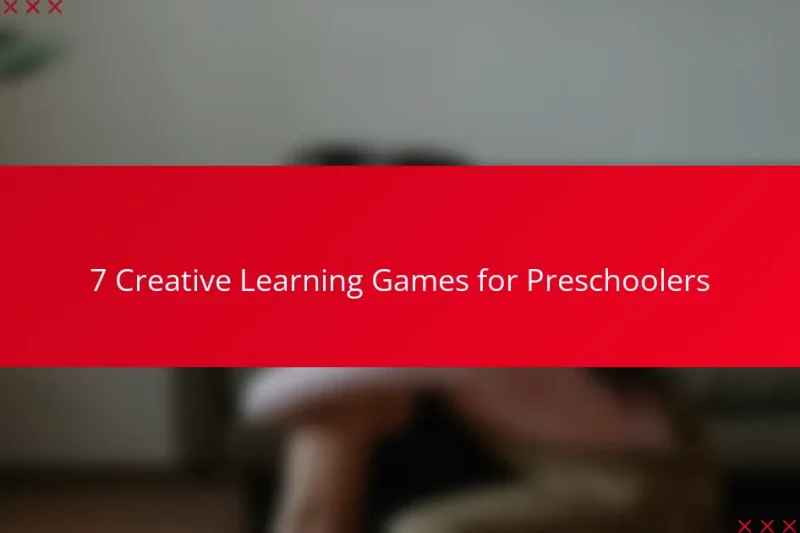Engaging children in budget-friendly educational crafts is a wonderful way to combine creativity with learning without … 7 Budget-Friendly Educational Crafts for KidsRead more
Engaging Educational Activities
Engaging educational activities play a crucial role in enhancing learning by fostering participation and critical thinking among students. By incorporating interactive experiences, these activities make the learning process more dynamic and enjoyable. Parents can further support this engagement at home by creating an environment that encourages creativity and exploration.
7 Creative Learning Games for Preschoolers
Creative learning games for preschoolers are fun and engaging activities designed to enhance cognitive, social, and … 7 Creative Learning Games for PreschoolersRead more
7 Interactive Storytelling Techniques for Young Children
Interactive storytelling techniques engage young children by transforming them into active participants in the narrative. These … 7 Interactive Storytelling Techniques for Young ChildrenRead more
7 Fun Educational Activities for 2-Year-Olds at Home
Engaging 2-year-olds in fun educational activities at home can significantly enhance their development while sparking their … 7 Fun Educational Activities for 2-Year-Olds at HomeRead more
7 STEM Activities for Early Childhood Development
Engaging young children in STEM activities is crucial for their early development, as these hands-on experiences … 7 STEM Activities for Early Childhood DevelopmentRead more
What engaging educational activities can enhance learning in classrooms?
Engaging educational activities that enhance learning in classrooms include interactive experiences that promote participation and critical thinking. These activities can vary widely, but they all share the goal of making learning more dynamic and enjoyable for students.
Interactive science experiments
Interactive science experiments allow students to engage directly with scientific concepts through hands-on activities. For example, conducting simple chemical reactions or building basic circuits can help students grasp complex ideas in a tangible way. These experiments should be safe, age-appropriate, and aligned with curriculum standards.
Consider using everyday materials for experiments to keep costs low and accessibility high. Always ensure that safety protocols are in place, and encourage students to hypothesize and discuss their findings to deepen understanding.
Group storytelling sessions
Group storytelling sessions foster creativity and collaboration among students. By encouraging them to create and share stories together, students develop communication skills and learn to appreciate diverse perspectives. These sessions can be structured around themes or subjects relevant to the curriculum.
To facilitate these sessions, provide prompts or story starters that guide students while allowing room for imagination. Encourage active listening and peer feedback to enhance the storytelling experience and build a supportive classroom environment.
Hands-on art projects
Hands-on art projects enable students to express themselves creatively while reinforcing concepts from other subjects. Activities like painting, sculpting, or collage-making can be integrated with lessons in history, science, or literature. This approach not only enhances creativity but also aids in retention of information.
When planning art projects, consider the materials required and the time needed for completion. Allow students to explore different techniques and styles, and showcase their work to build confidence and pride in their accomplishments.
Outdoor educational games
Outdoor educational games combine physical activity with learning, making them an effective way to engage students. Activities like scavenger hunts or nature walks can teach concepts related to biology, geography, or environmental science while promoting teamwork and problem-solving skills.
Ensure that games are designed to be inclusive and accessible for all students. Incorporate elements of competition or collaboration to motivate participation, and debrief after the activity to reinforce learning outcomes.
Virtual reality field trips
Virtual reality field trips provide immersive learning experiences that transport students to different environments and cultures without leaving the classroom. These trips can cover a wide range of topics, from historical landmarks to natural wonders, enhancing students’ understanding of the world.
When implementing VR field trips, ensure that the technology is user-friendly and that students have adequate time to explore. Follow up with discussions or projects that allow students to reflect on their experiences and connect them to the curriculum.
How can parents support engaging educational activities at home?
Parents can support engaging educational activities at home by creating an environment that encourages creativity and exploration. This involves providing resources, setting aside time for learning, and participating in activities alongside their children.
Creative DIY projects
Creative DIY projects allow children to express themselves while learning valuable skills. Parents can encourage this by providing materials like cardboard, paint, and craft supplies, and suggesting projects such as building a birdhouse or creating a scrapbook.
Consider setting up a dedicated crafting space where kids can freely explore their ideas. This can foster independence and problem-solving skills as they navigate their projects.
Educational board games
Educational board games are a fun way to combine play with learning. Games that focus on math, vocabulary, or strategy can enhance critical thinking and social skills. Look for games that are age-appropriate and encourage teamwork.
Examples include classics like Scrabble for vocabulary or Monopoly for basic financial literacy. Regular game nights can become a cherished family tradition while reinforcing educational concepts.
Science kits for home experiments
Science kits for home experiments provide hands-on learning experiences that spark curiosity. These kits often include everything needed for experiments, making them accessible and easy to use. Look for kits that align with your child’s interests, such as chemistry, biology, or physics.
When conducting experiments, ensure safety by following instructions carefully and using appropriate safety gear. This can turn learning into an exciting adventure while teaching the scientific method.
Reading challenges
Reading challenges can motivate children to explore new genres and improve their literacy skills. Parents can set goals, such as reading a certain number of books each month, and reward achievements with small incentives like a special outing or a new book.
Creating a cozy reading nook and scheduling regular reading time can enhance the experience. Consider joining local library programs that offer reading challenges to encourage community involvement and access to diverse reading materials.
What are the benefits of engaging educational activities?
Engaging educational activities provide numerous advantages, including increased motivation, improved critical thinking, and better retention of information. These activities stimulate interest and encourage active participation, which enhances the overall learning experience.
Improved student motivation
Engaging educational activities significantly boost student motivation by making learning enjoyable and relevant. When students participate in hands-on projects or interactive lessons, they are more likely to feel invested in their education.
To enhance motivation, consider incorporating gamification elements, such as rewards or challenges, into lessons. This approach can lead to a more dynamic classroom environment and encourage students to take ownership of their learning.
Enhanced critical thinking skills
Engaging activities foster critical thinking by encouraging students to analyze, evaluate, and create. Activities that require problem-solving or decision-making help students develop these essential skills.
For example, group discussions or debates on relevant topics can promote deeper understanding and encourage students to consider multiple perspectives. Incorporating real-world scenarios into lessons can also challenge students to apply their knowledge critically.
Better retention of information
When students are actively engaged in their learning, they are more likely to retain information. Engaging educational activities create memorable experiences that help solidify knowledge in long-term memory.
Techniques such as project-based learning or experiential learning can enhance retention. For instance, students who participate in field trips related to their studies often recall information better than those who learn solely from textbooks.
What criteria should educators consider when selecting activities?
Educators should consider factors such as age appropriateness, alignment with curriculum standards, and resource availability when selecting educational activities. These criteria ensure that the activities are effective, engaging, and feasible within the educational environment.
Age appropriateness
Age appropriateness is crucial for ensuring that activities resonate with students and match their developmental stages. Activities should be designed to challenge students without causing frustration, typically aligning with the cognitive and emotional maturity of the target age group.
For example, younger children might benefit from hands-on, sensory-based activities, while older students may engage better with complex problem-solving tasks. Always consider the specific age range when planning to maximize engagement and learning outcomes.
Alignment with curriculum standards
Activities must align with established curriculum standards to ensure that they meet educational goals and learning objectives. This alignment helps educators maintain consistency in teaching and provides a framework for assessing student progress.
Familiarize yourself with local or national standards relevant to your subject area. For instance, in the U.S., educators might refer to the Common Core State Standards for guidance, while in Europe, national education frameworks may apply. This ensures that selected activities contribute meaningfully to students’ overall learning trajectories.
Resource availability
Resource availability is a practical consideration that can significantly impact the feasibility of implementing educational activities. Educators should assess whether they have access to the necessary materials, technology, and space before selecting an activity.
For instance, an activity requiring specific software or equipment may not be feasible in a school lacking those resources. Create a checklist of available resources and compare it against the requirements of potential activities to avoid last-minute challenges and ensure smooth execution.
How do engaging educational activities vary across different age groups?
Engaging educational activities differ significantly across age groups, reflecting the developmental stages and learning needs of children. Preschoolers thrive on play-based learning, while elementary and middle school students benefit from more structured and challenging tasks that promote critical thinking and collaboration.
Activities for preschoolers
Preschoolers learn best through interactive play and hands-on experiences. Activities like storytelling, simple arts and crafts, and sensory play using materials like sand or water can enhance their motor skills and creativity.
Incorporating music and movement into learning can also be effective. For instance, singing songs that teach numbers or letters while engaging in dance helps reinforce concepts in a fun way.
Activities for elementary students
Elementary students benefit from a mix of individual and group activities that foster both independence and teamwork. Projects such as science experiments or group presentations can encourage collaboration and critical thinking.
Incorporating technology, like educational games or coding activities, can also engage this age group. Hands-on activities, such as building models or conducting simple experiments, can make learning more tangible and enjoyable.
Activities for middle schoolers
Middle schoolers are ready for more complex and abstract concepts, so activities should challenge their analytical skills. Debates, research projects, and problem-solving tasks can stimulate critical thinking and encourage deeper understanding.
Encouraging participation in extracurricular activities, such as clubs or sports, can also enhance social skills and teamwork. Additionally, integrating real-world applications, like community service projects, helps students connect their learning to everyday life.




